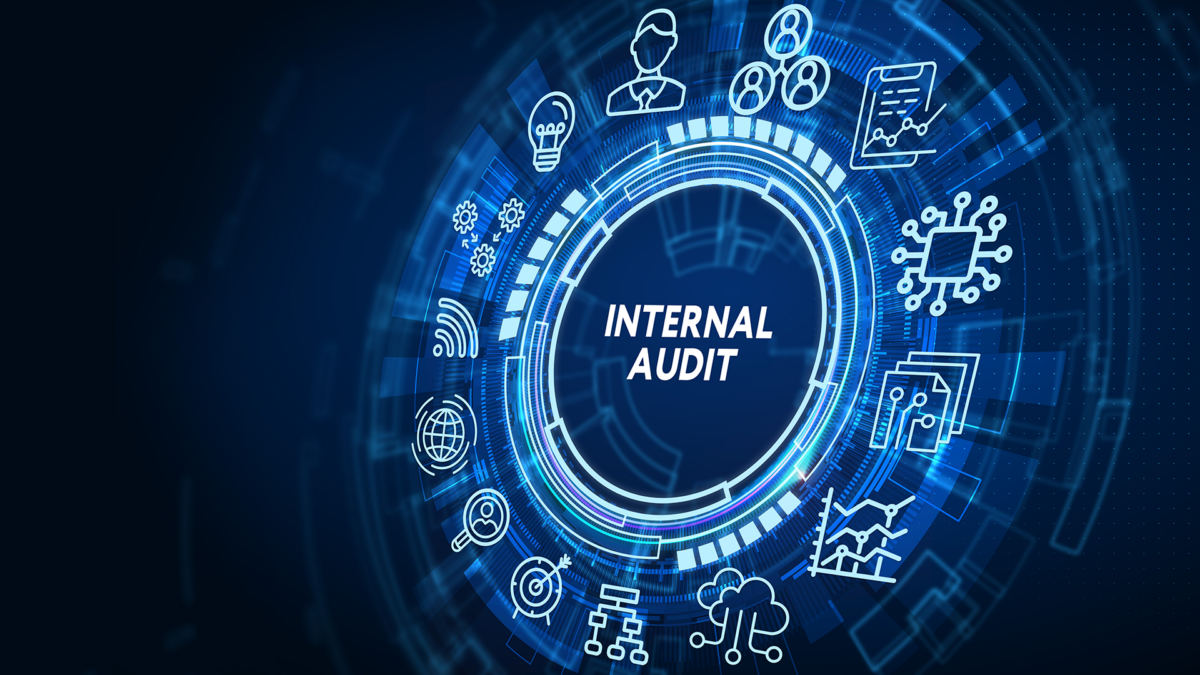Found this helpful? Share it with peers.
Introduction
In today’s jungle of regulations, internal audits carry more weight than ever. What was once a scheduled formality is now expected to uncover weaknesses, confirm compliance, and hold up under external review. This change has revealed the limits of outdated audit practices. Manual checks and scattered documentation slow teams down and allow critical issues to go unnoticed.
Some organizations still rely on scattered audits with little coordination. Others use a more centralized approach that connects audits to broader risk and control systems. They identify risks three times earlier and avoid 70% more compliance issues compared to those using outdated methods.
In this blog, we break down what makes audit practices more effective in practice. You’ll see how the right structure and tools can shift audits from reactive checks to a reliable part of risk control.
What is Audit Management ?
Let’s break down the essentials. Audit management covers how internal audits are planned and carried out. It’s a structured process, but in practice, it often adapts to what the organization needs at the time.
The scope usually includes risk-based planning, fieldwork, documentation, and follow-up on findings. Some teams focus more on process design. Others look at control gaps or how risks are being handled in specific areas.
Unlike external audits, which are done by independent third parties, internal audits are handled by professionals within the organization. They provide insights that go beyond the financial aspects, such as operational efficiency, internal controls, IT risks and regulatory compliance. Depending on the goal, they can be used to improve internal practices or in preparation for external certification.
Why is Audit Management important?
Internal audit management acts as an independent and objective guarantor for the executive board and the board directors.
Its main objectives are :
- Evaluating effectiveness of governance, risk management, and internal controls
- Identifying inefficiencies and risks across business functions
- Providing actionable recommendations to improve processes and safeguard assets
- Monitoring follow-up and implementation of corrective actions
When audit tasks are followed through regularly, things tend to show up that don't always surface in routine reports. Some of these may seem minor at first but turn out to be signs of larger problems. Internal audit draws attention to those areas and keeps the process moving. It doesn't stop at findings — it forces follow-up, which is often where things break down. For leadership, that means less guesswork. They're looking at actions taken, not just what was flagged.
Why is Audit Management crucial for GRC?
In the GRC context, audit management helps organizations stay aligned with what’s required by law, by regulators, and by internal policy. It surfaces weak points in controls early, while there’s still time to respond. When risks come up, audit teams follow through by assigning responsibility and tracking what actually gets done.
The role of audit management goes beyond spotting risk. It creates structure around oversight and makes it easier to hold teams accountable. In many cases, it also exposes inefficiencies that slow operations or cause repeated issues. When used effectively, audit work becomes a safeguard that protects both financial stability and the company’s reputation.
The Main Types of GRC Audits
Audit management can take many forms. Some audits are narrow and look at one issue. Others cover a wider area. The type of audit determines its purpose and focus. Some common types include:
| Audit Type: | Purpose: | Focus Areas: |
|---|---|---|
| Internal Audit | Self-assessment | Ops effectiveness, internal controls |
| External audit | Independent validation | Financials, regulatory alignment |
| Compliance Audit | Verify adherence to laws/standards | Data protection, anti-corruption, regulations |
| Operational Audit | Assess performance and resource use | Process efficiency, effectiveness |
| Financial Audit | Review financial records and processes | Reporting accuracy |
| IT Audit | Evaluate tech systems and security | Data integrity, access controls, availability |
| Supplier Audit | Assess third-party vendors | Contracts, risks, delivery performance |
| Quality Audit | Examine quality management systems | Product standards, quality control |
| Environmental Audit | Ensure sustainability compliance | Emissions, environmental regulations |
Understanding the differences between audit types is essential for building an effective audit strategy. In practice often audits do overlap, so in many cases organizations also combine multiple audit types to address cross-functional risks or complex regulatory requirements. Therefore, knowing the specific type helps to define the scope, set priorities, and allocate the right resources.
Audit Process: From Risk Identification to Follow-Up
A typical internal audit process consists of six key phases:
- Risk Assessment & Audit Planning
Identify and evaluate organizational risks. Use risk scores to define a risk-based audit universe and prioritize audit areas. - Audit Preparation
Outline the audit scope, define audit objectives, and create an audit plan. - Fieldwork / Execution
Conduct interviews, review documentation, and gather evidence through testing and observation. - Findings & Recommendations
Document observations, assess root causes, and propose corrective actions. - Audit Reporting
Consolidate findings and recommendations in a formal report to management. - Follow-Up & Monitoring
Track whether recommendations are implemented and assess their effectiveness through periodic follow-ups conducted at defined intervals.
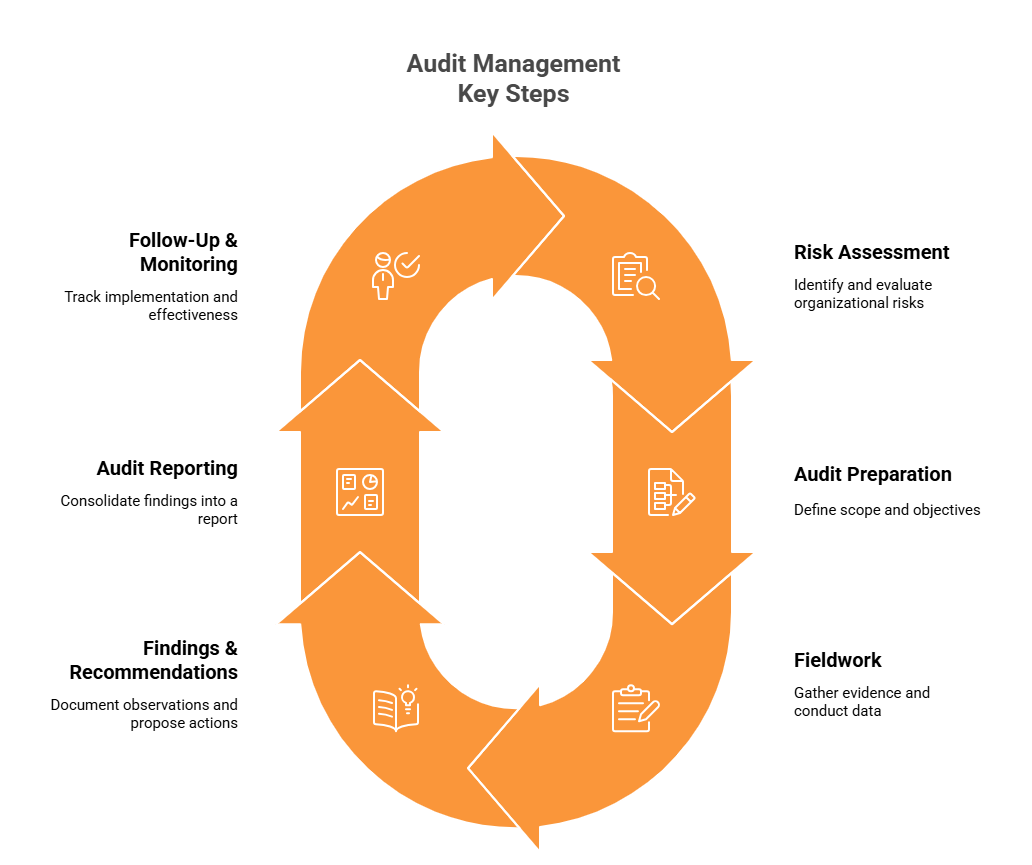
Overview of audit process
The Limits of Manual Audits
Manual audits might have been effective previously, but they are not scalable. As companies expand, all the paper records and Excel spreadsheets rapidly turn into obstacles for productivity and risk awareness.
Here's where manual audits fall short in practice:
Time-consuming processes:
Collecting evidence, drafting reports and analyzing data manually slows processes down.
High risk of errors:
Manual data increases the probability of mistakes and inconsistencies.
Lack of standardization:
Without uniform methods, audit quality can vary significantly.
Unreliable documentation:
Missing files or incomplete audit trails hinder accountability and traceability.
Limited visibility:
Siloed reports delay risk detection and resolution.
Increasing costs:
Manual tasks require more time and resources.
Compliance gaps:
Regulatory changes often keep spreadsheet-based systems out of date.
Weak collaboration:
Without a central platform, teamwork and oversight suffer.
In many cases, these weaknesses turn internal audits into reactive exercises with limited long-term value.
How GRC Tools can streamline Internal Audit
With modern GRC tools like ADOGRC, internal audit teams adopt a more centralized and structured approach. This helps reduce manual effort and align audits with internal processes.
When audit activities are connected to risks and controls, teams gain immediate insight into where gaps exist and can respond without delay. Dashboards show progress and outcomes, making audit results visible across departments. This clarity also supports ongoing audit management by tracking execution and follow-up actions over time. The result is more reliable oversight and better coordination across the organization.
This foundation unlocks a range of improvements across how internal audits are planned, executed, and followed through in ADOGRC:
1. Improved Efficiency & Automation
ADOGRC enables a more efficient audit process through capabilities such as:
-
More automated audit workflows, including scheduling, notifications, task assignments, and follow-ups
-
Streamlined planning, evidence collection, and reporting with reduced manual effort
-
Centralized documentation that replaces spreadsheets and fragmented audit logs
-
Dashboards showing real-time audit status, overdue tasks, and escalation levels
-
Built-in workflow logic that links each audit step to roles, processes, and related data
-
A structured view of all scheduled audits and responsible parties within the audit programme

Structured schedule of your audit programme
2. Better Risk and Compliance Alignment
ADOGRC strengthens the connection between audits, risks, and controls by enabling:
-
Integration of audits with compliance library, allowing internal auditors to test controls directly against compliance requirements
-
Real-time visibility into compliance gaps, making it easier to address issues without delay
-
Direct access to control testing and execution data, supporting more accurate risk assessments during audits
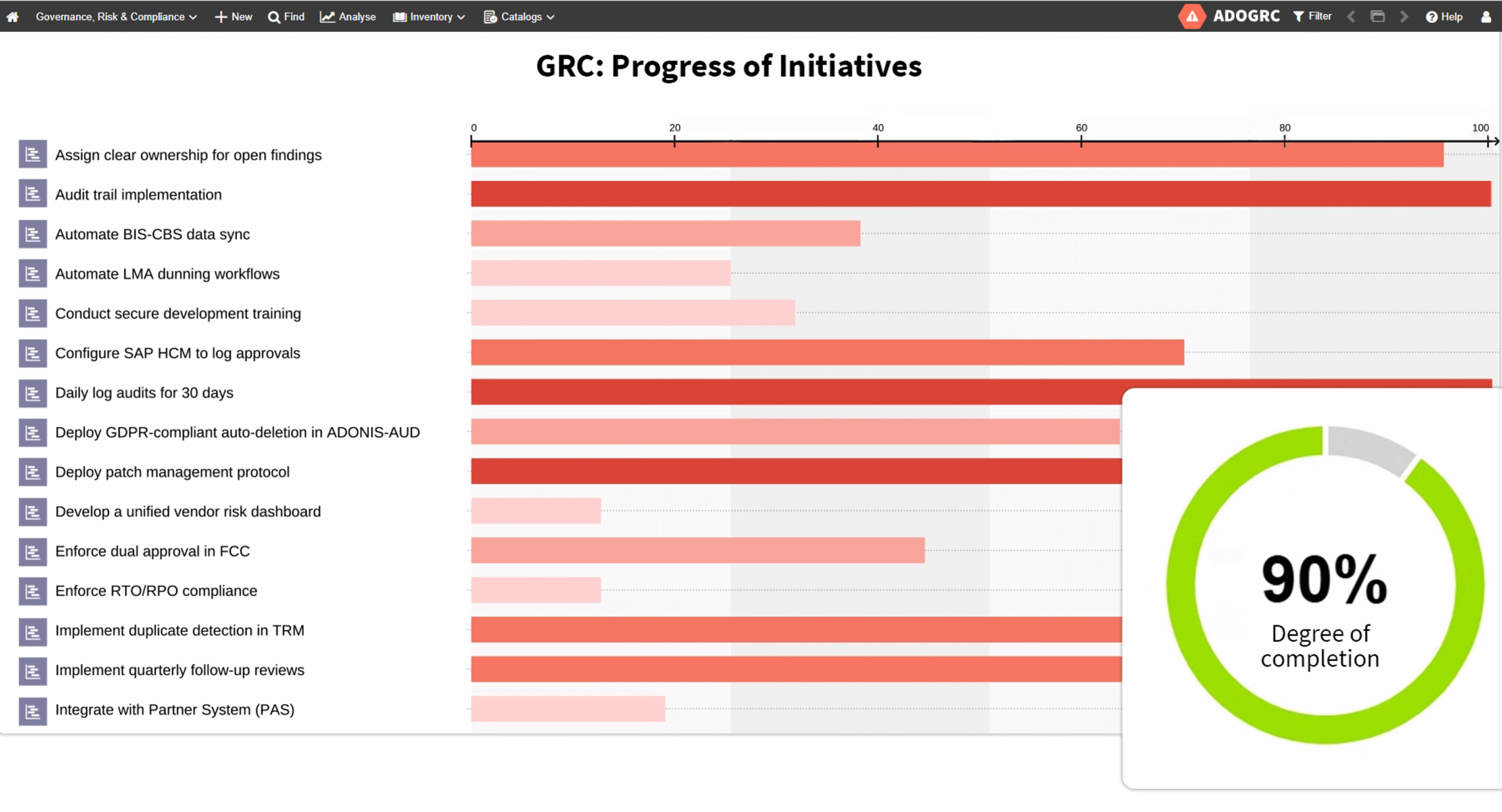
Progress tracking of initiatives in ADOGRC
3. Transparency & Accountability
ADOGRC improves audit transparency and ensures responsible handling of findings through:
-
Full audit trail tracking that logs all actions taken, including who performed them and when
-
Dashboards that show the impact of corrective actions and make follow-up efforts traceable
-
A dedicated ‘All pending actions’ section that provides users with a clear view of outstanding tasks
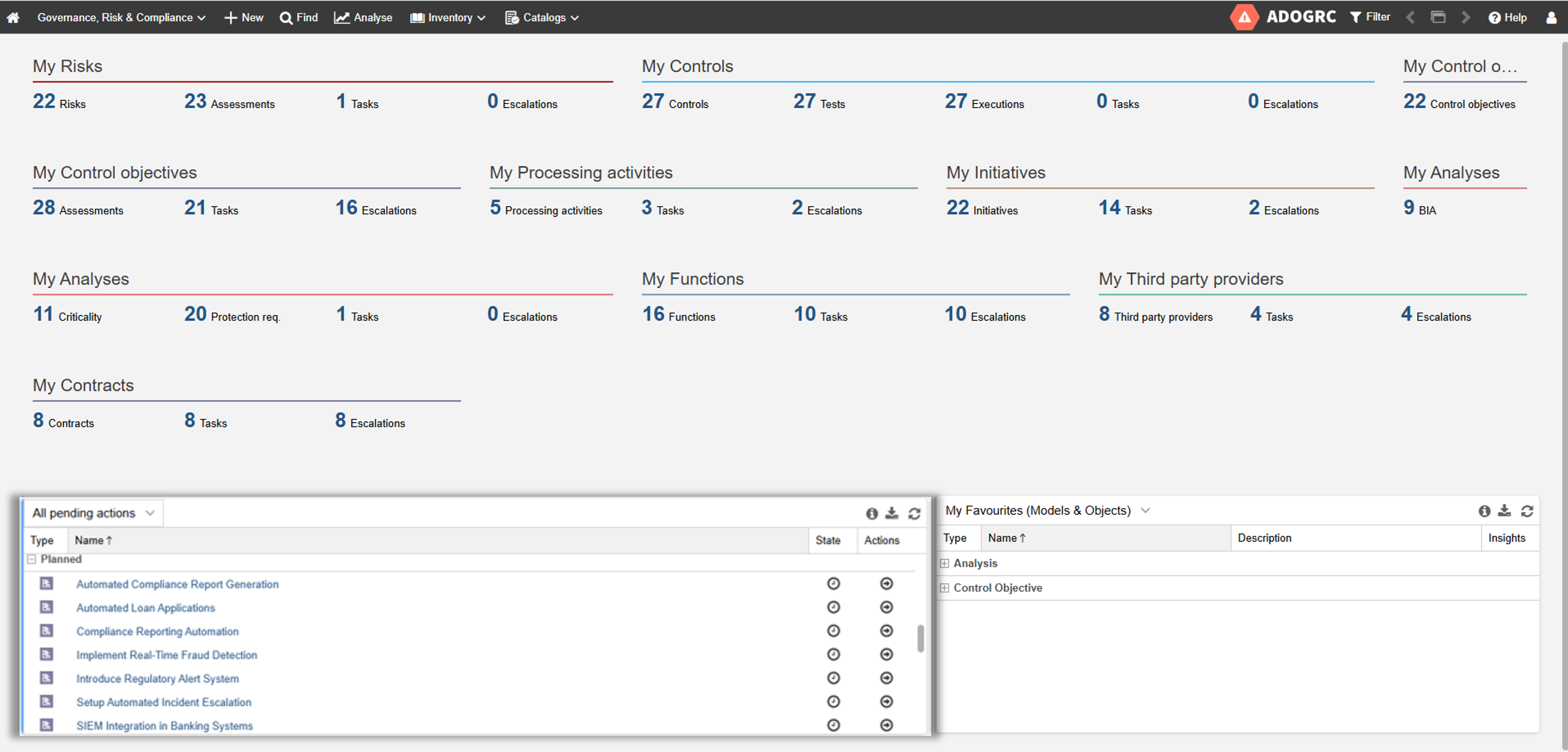
Progress tracking of initiatives in ADOGRC
4. Data-Driven Insights
ADOGRC enables internal audit teams and stakeholders to work with meaningful data by providing:
-
Dashboards and reports that support better understanding of developments and reveal areas requiring attention
-
Continuous monitoring capabilities that support risk-based auditing and early detection of deficiencies
-
Visual analysis tools, including matrix and bubble charts, that support root cause analysis of findings and related actions
-
KPI-based reports and real-time metrics that help optimize the audit programme and assess audit readiness
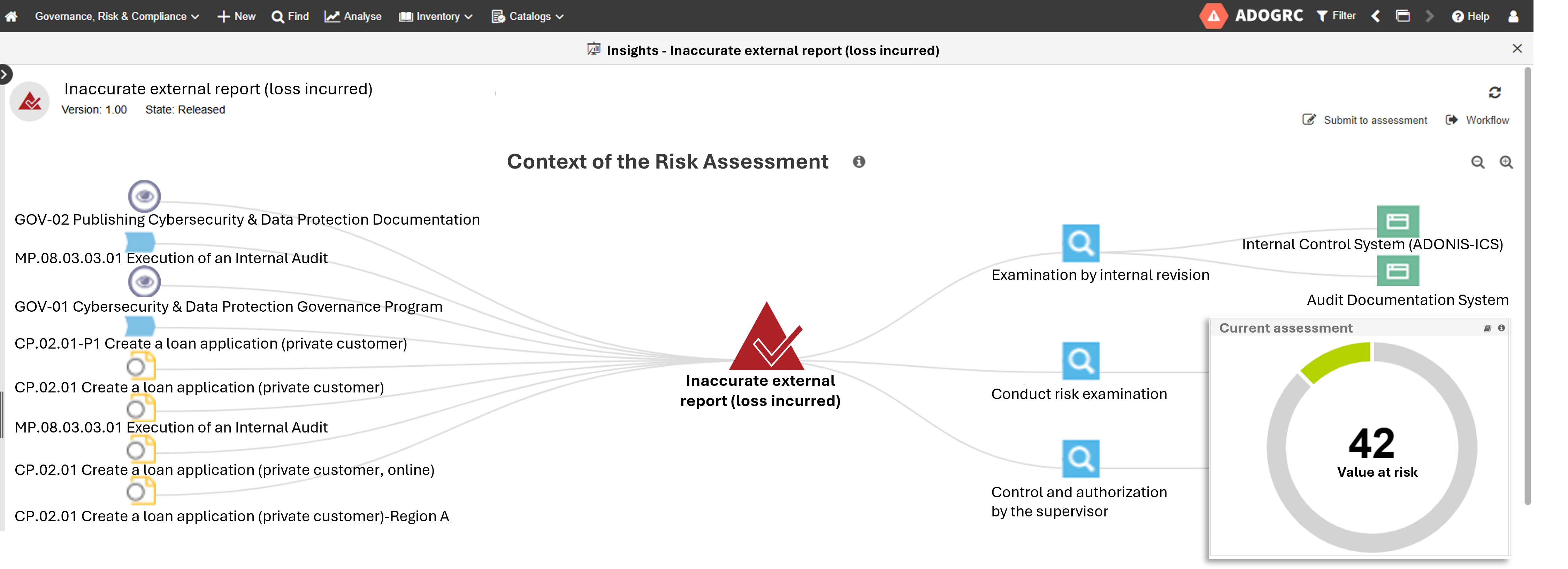
Data-Linked Risk Analysis Overview
5. Scalability & Standardization
ADOGRC supports consistent and scalable audit practices across the organization through:
-
Support for a wide range of audit types, including internal, IT, compliance, and third-party/vendor audits
-
A central regulation catalogue and scoped inventories that enable reusable audit planning at scale
-
Scenario-specific extensions such as BCM or DORA audits, with predefined object types and DORA-compliant report exports via REST-XLS_Reports to meet governance requirements
6. Enhanced Collaboration
ADOGRC improves cross-functional coordination by providing:
-
A centralized platform for internal auditors and compliance teams to work in one shared environment
-
Workflow-driven collaboration that ensures findings reach the right stakeholders – with built-in follow-up support
-
Integration with process, function, and application objects to ensure seamless context sharing between audit and business views
7. Integrated Action Management
ADOGRC supports structured follow-up by turning audit results into actionable outcomes:
-
Findings can be directly converted into tracked actions with due dates, responsibilities, and completion metrics
-
A centralized overview of all findings simplifies the monitoring of remediation progress and effectiveness
Organizations using tools like ADOGRC report up to 40% shorter audit cycles and twice as fast resolution of findings compared to manual methods.
Summary
Audits don’t add much value when they’re buried in spreadsheets or scattered across inboxes. Teams waste time looking for information instead of acting on it. When audits are supported by a tool that handles the complexity of the work, teams can focus on what matters instead of chasing documents or repeating manual steps.
With a platform like ADOGRC, audit management becomes easier to coordinate. It brings planning, tracking, and follow-up into one space, so internal auditors can spend less time on admin and more time addressing the risks that affect the business directly.
References:
MetricStream. (n.d.). What is GRC audit? A detailed guide for 2025. Retrieved July 15, 2025, from https://www.metricstream.com/learn/grc-audit-guide.html
Sprinto. (2024, October). GRC audit: Key areas, checklist & preparation tips. Retrieved July 15, 2025, from https://sprinto.com/blog/grc-audit/
OCEG. (2024). What is an audit? A GRC guide to internal audit, IT audit, business assurance, and more. Retrieved July 15, 2025, from https://www.oceg.org/it-audit-and-assurance-guide-grc/
GRC 20/20 Research. (n.d.). Audit management & analytics. Retrieved July 15, 2025, from https://grc2020.com/product-category/grc-functional-area/audit-management-analytics/
RSI Security. (2022, November 15). What is a GRC audit and how does it work? Retrieved July 15, 2025, from https://blog.rsisecurity.com/what-is-a-grc-audit-and-how-does-it-work/

